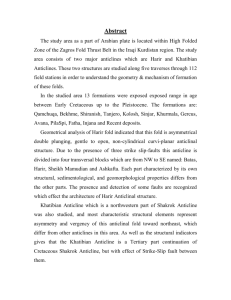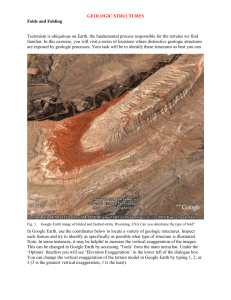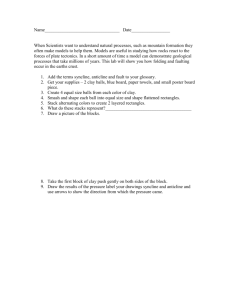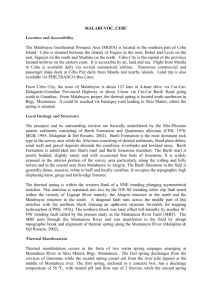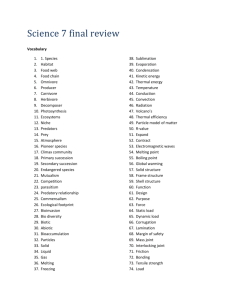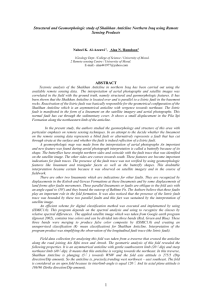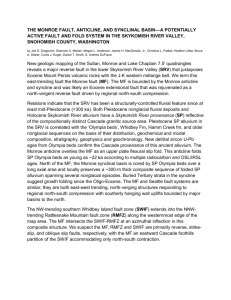6, 29-46 ISSN: 1792-9040 (print), 1792-9660 (online)
advertisement
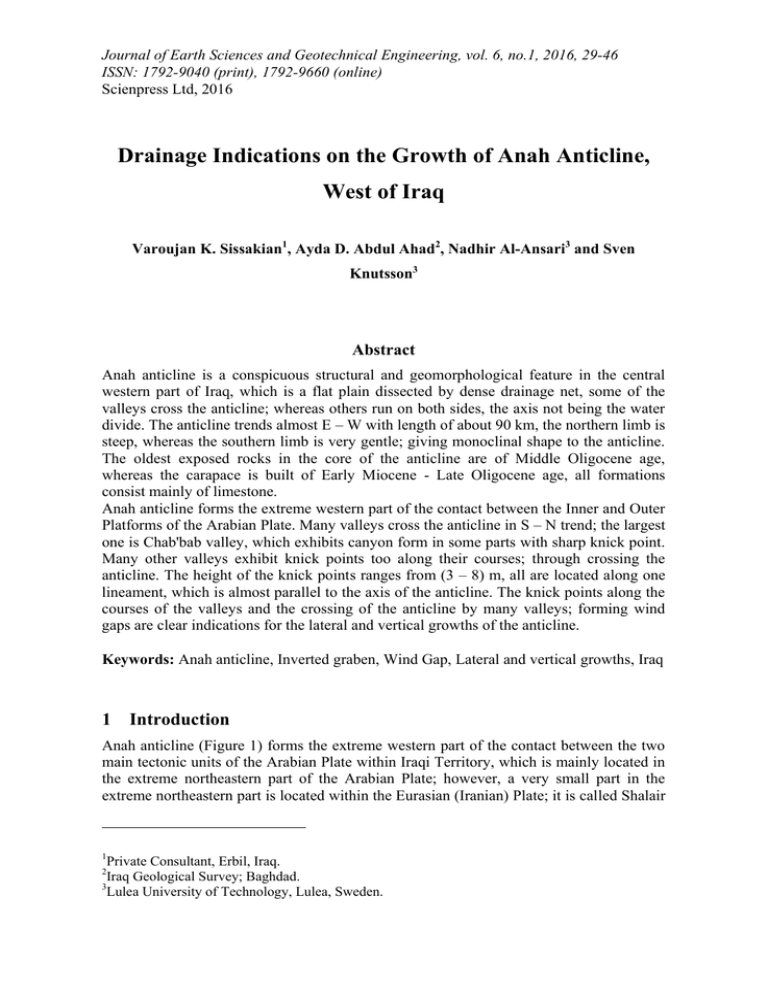
Journal of Earth Sciences and Geotechnical Engineering, vol. 6, no.1, 2016, 29-46 ISSN: 1792-9040 (print), 1792-9660 (online) Scienpress Ltd, 2016 Drainage Indications on the Growth of Anah Anticline, West of Iraq Varoujan K. Sissakian1, Ayda D. Abdul Ahad2, Nadhir Al-Ansari3 and Sven Knutsson3 Abstract Anah anticline is a conspicuous structural and geomorphological feature in the central western part of Iraq, which is a flat plain dissected by dense drainage net, some of the valleys cross the anticline; whereas others run on both sides, the axis not being the water divide. The anticline trends almost E – W with length of about 90 km, the northern limb is steep, whereas the southern limb is very gentle; giving monoclinal shape to the anticline. The oldest exposed rocks in the core of the anticline are of Middle Oligocene age, whereas the carapace is built of Early Miocene - Late Oligocene age, all formations consist mainly of limestone. Anah anticline forms the extreme western part of the contact between the Inner and Outer Platforms of the Arabian Plate. Many valleys cross the anticline in S – N trend; the largest one is Chab'bab valley, which exhibits canyon form in some parts with sharp knick point. Many other valleys exhibit knick points too along their courses; through crossing the anticline. The height of the knick points ranges from (3 – 8) m, all are located along one lineament, which is almost parallel to the axis of the anticline. The knick points along the courses of the valleys and the crossing of the anticline by many valleys; forming wind gaps are clear indications for the lateral and vertical growths of the anticline. Keywords: Anah anticline, Inverted graben, Wind Gap, Lateral and vertical growths, Iraq 1 Introduction Anah anticline (Figure 1) forms the extreme western part of the contact between the two main tectonic units of the Arabian Plate within Iraqi Territory, which is mainly located in the extreme northeastern part of the Arabian Plate; however, a very small part in the extreme northeastern part is located within the Eurasian (Iranian) Plate; it is called Shalair 1 Private Consultant, Erbil, Iraq. Iraq Geological Survey; Baghdad. 3 Lulea University of Technology, Lulea, Sweden. 2 30 Varoujan K. Sissakian et al. Terrane. The Arabian Plate within the Iraqi territory includes; as aforementioned two main units: Inner Platform and Outer Platform, the former is the stable one, whereas the latter is the unstable one being influenced by tectonic forces exerted by collision of the Arabian and Eurasian Plates. The contact between the Inner and Outer Platforms run almost parallel to the Euphrates River. In the extreme western part; it is represented by Anah Active Fault Zone, which met Abu Jir – Euphrates Active Fault Zone that extends southeast wards to Basrah vicinity, in the extreme southern part of Iraq. It is the last existing surface anticline in Iraqi Territory; as ascending from north and northeast towards south and southwest; forming and outstanding feature in a wide flat plain.Different researchers studied Anah anticline and its vicinity. Among these researchers is Al- Mubarak [1]. He executed a geological map for the whole area in which the anticline extends and recorded the characteristics of the anticline and the exposed rocks. Sissakian and Qanber[2] and Sissakian[3] compiled the geological maps at scale of 1:25000 that include the whole Anah anticline and explained the relation between the structure, geomorphology and stratigraphy. Later, [4] reported a Neotectonic activity in Anah anticline. Fouad[5 and 6] presented the details of Anah anticline and its relation with Anahgraben and he reported that Anah anticline represents the western part of Anah – Abu Jir Fault Zone, which represents the contact between the two major tectonic units in Iraq. Figure 1: Google Earth image of Anah anticline The aim of this study is to elucidate the lateral and vertical growths of Anah anticline, indicating Neotectonic activity in the concerned area, which is located in the extreme western central part of Iraq; along the Euphrates River (Figure 1). Different geological articles and reports were compiled for this purpose and Google Earth images were used in addition to field observations to achieve this goal. 2 Geological Setting Anah anticline is a conspicuous geomorphological feature in a wide flat area on both sides. The acute asymmetry of the anticline, gives it a monoclinal form with few Cuestas along the northern limb. The maximum elevation along the anticline is about 300 m (a.s.l.), which is located almost along the axis of the anticline; in the eastern part [1,2,3,4,5]. Drainage Indications on the Growth of Anah Anticline, West of Iraq 31 The exposed rocks in the anticline belong to Baba (Middle Oligocene), Anah (Late Oligocene) and Euphrates (Late Miocene) formations (Figure 2). The main rock type of the exposed formations is limestone, with some dolomite and marl intercalations. The limestone of the Anah Formation is very hard – extremely hard, also the lowermost part of the Euphrates Formation; above the basal conglomerate, which forms the unconformable contact between Anah and Euphrates formations. The exposures of the Anah Formation are restricted to the core along the axis in the extreme eastern part of the anticline, besides many exposures along some deeply cut valleys, which cross the anticline (Figure 2). Anah anticline is long (90 km), wide (3 – 5 km), E – W trending, double plunging; with steeply dipping (10 – 35) northern limb and very gently dipping (about 5) southern limb; giving it monoclinal form [2,3] (Figure 3). The eastern plunge is not clear; since it is across the Euphrates River and partly within the river. The anticline was previously a subsurface graben, which was inverted to anticline starting from the end of the Late Cretaceous to Paleocene [4,5]. Figure 2: Geological Map of the study area, showing Anah anticline [4]. 32 Varoujan K. Sissakian et al. Figure 3: Geological cross section through Anah anticline [7]. Note the thickness of the Cretaceous rocks in the graben, as compared on both sides; indicating continuous subsidence during Cretaceous forming syn-rift sediments. 3 Anah Anticline Anah anticline is located within AnahGraben, which is an ENE trending, 250 Km long and (7–20) km wide subsurface graben extending from Al-Qaim town; near the Iraqi–Syrian borders eastwards to the vicinity of Tharthar valley. It is an intercontinental rift basin formed during the Campanian – Maastrichtian and was subsequently filled by Upper Cretaceous syn-rift sediments that display a dramatic thickness increase within the fault bounded basin (Figures 3 and 4). The active basin subsidence was terminated by the end of the Maastrichtian, and then followed by deposition of relatively thin Tertiary post-rift sediments [5]. The Anahgraben is subdivided into five main segments [8]. They are, from east to west, non-inverted symmetrical graben, non-inverted half-graben, inverted half-graben, inverted symmetrical graben, and non-inverted symmetrical graben [5]. The monoclinal shape of Anah anticline is manifested by the inverted half-graben (Figure 4), which forms the majority of the involved area by Anah anticline. The boundary between the Inner Platform (stable part) and the Outer Platform (unstable part) of the platform is along Abu Jir – Anah Fault Zones [5]. Anah Fault Zone (or commonly AnahGraben) extends more than 100 Km in East – West direction from Al-Qaim city, in the Iraqi – Syrian borders to the east of Anah city, and then meets Abu Jir Fault Zone [6]. Therefore, the involved area has witnessed tectonic unrest; as indicated by many features; among them are: 1) the drainage system across Anah anticline, 2) the abnormal water divide along the anticline (Figure 5), 3) the strange developed drainage systems, 4) presence of wind gaps, and 5) the developed knick points along many valleys, all are the main objectives of this study; to indicate and confirm the lateral and vertical growths of Anah anticline. Drainage Indications on the Growth of Anah Anticline, West of Iraq 33 Figure 4: Inverted half-graben giving a monoclinal shape to Anah anticline (After [5]). 4 Drainage System In normal cases, the axis of the anticline usually exhibits water divide line along both limbs of an anticline, especially in whale-back shaped anticlines. This case; however, is not a rule, as the anticline exhibits acute asymmetry; as the water divide line deviates from the axis. Moreover, the drainage may cross the anticline forming water gaps and may change to wind gaps indicating lateral and vertical growths of the anticline [8,9,10,11,12,13]. This is the case in Anah anticline, where some of the valleys cross both limbs, others run parallel to the axis, and another's run parallel to the axis then deviate to be perpendicular to the axis (Figure 5). Figure 5: Google Earth image of Anah anticline and the developed water divides and drainage systems. Note the abnormal water divides; as related to Anah anticline.Valleys: 1 = Perpendicular to the axis, 2 = Parallel to the axis, 3 = Parallel to the axis then turns perpendicular to the axis, and 4 = Off the axis 4.1 Knick Points Many valleys in the study area exhibit knick points (Figure 6), knick points are location of a river or channel where there is a sharp change in channel slope, such as a waterfall or lake. Knick points reflect different conditions and processes on the river often caused by previous erosion due to glaciation or variance in lithology[14]. The height of the knick 34 Varoujan K. Sissakian et al. points ranges from (3 – 8) m; they are formed in very hard limestone beds, which have compressive strength of (145 – 170) MPa [15,16]. They all are almost aligned on a straight line that runs parallel to the axis of Anah anticline, indicating weakness zone due to tension joints and cracks and/ or Neotectonic activity due to the activity of Anah Fault Zone [4,5,6]. Figure 6: Google Earth image (Facing South) for many valleys exhibiting knick points (KP). 4.2 Shifted Drainage Courses Tens of valleys in the study area had shifted their courses, flowing either vertical or parallel to the trend of the anticline; the shifts are always parallel to the anticline; indicating upward movement parallel to the anticline. Figure 7 represents two northwards draining valleys being shifted southwards due to continuous uplifting. Figure 7: Google Earth images for two valleys shifted eastwards, due to continuous uplift, with the mentioned detailed scenario. Drainage Indications on the Growth of Anah Anticline, West of Iraq 35 Figure 8: Represents different valleys shifted from their original courses also, indicating lateral and vertical growth of the anticline, without the growth, the valleys wouldn't exhibit such abnormal meandering and shifting. 4.3 Fork-shaped Valleys One of the characteristics of lateral and vertical growths of anticlines is the development of "Fork-shaped valleys" [9,10,11,12,13]. Figure 9 illustrates fork-shaped valleys developed on both sides of a main valley within the study area. Also not the developed Knick point along the course of the main valley; downstream of the knick point the fork-shaped valleys are developed. 4.4 Wind Gaps Many valleys dissect Anah anticline forming wind gaps (Figure 10). They dissect the anticline in different parts and run northwards; before reaching the southern limb, the valleys forms acute meanderings, then all return to their original northwards trend. These meanders are most probably developed due to the presence of weakness zones that are parallel to the axis of the anticline. The weakness zones show activity parallel to their trends; as indicated by the development of the acute meanders along many valleys along a straight alignment. 36 Varoujan K. Sissakian et al. K P F V Figure 9: Google Earth image showing 'Fork-shaped valleys" (FV) and Knick point (KP) developed along a valley, indicating lateral and vertical growth of Anah anticline. The presence of many wind gaps is clear indication for the lateral growth of an anticline [9,10,11,12,13]; therefore, those wind gaps are considered as indications for the lateral growth of Anah anticline. Some of the valleys that had developed wind gaps along their courses, form fork-shaped small rills along the banks of their main courses; a good example is Chab'bab valley (Figure 11). 5 Results Anah anticline is E – W trending with length of about 90 Km and width of about (3 – 5) Km, double plunging; with steeply dipping (15 – 35) northern limb and very gently dipping (about 5) southern limb; giving it monoclinal form. It is dissected by many valleys; however, the majority of valleys either flow northwards or eastwards with many water divides, which are controlled by the topography, but less with the structure effect; as an anticline. Tens of valleys exhibit changes in their courses and abnormal meanders. Others form Knick points along their courses; with height of (3 – 8) m. Few main valleys show fork-shaped rills, and others exhibit wind gaps. All these features are indication of lateral and/ or vertical growth of Anah anticline. Drainage Indications on the Growth of Anah Anticline, West of Iraq A n 1 a i h c A i l 37 n n 3t e 2 Figure 10: Google Earth image showing many valles crossing Antah anticline and forming wind gaps. 1 = Batikhah, 2 = Chab'bab and 3 = Khazgah Al- Shargi. wind gaps. 1 = Batikhah, 2 = Chab'bab and 3 = Khazgah Al- Shargi. Figure 11: Google Earth images. Left) Wadi Cahb'bab, Right) Wadi Khazgah Al-Shargi (KSH) and Khazgah Al-Gharbi (KGH), all of them show fork-shaped small rills on their banks along wind gaps. 38 Varoujan K. Sissakian et al. 6 Discussion 6.1 Wind Gaps One of the main features that indicate the lateral and vertical growths of anticlines is the water and wind gaps [10,11,12]. If a fold starts to propagate laterally and the incision rate of the river is higher than the uplift rate of the fold, then a gorge, called "water gap", will be established. If the incision rate of the river becomes lower than the uplift rate of the folds during further growth of the anticline, the river gets defeated and diverted leaving behind a dry valley called wind gap [10,11]. Elevations of wind gaps along the crest of the fold may reveal the direction of the folds plunge and hence the direction of the lateral propagation. Drainage parallel to a fold axis will likely be diverted in the direction of propagation, as diversions develop, tributary streams are captured and the size of the upstream drainage basin increases until there is sufficient stream power to maintain a channel temporarily at the nose of the fold where propagation has not yet occurred [12]. Good example is wadiChab'bab (Figures 10 and 12 A) and wadi Al-Qasir (Figure 13). This area becomes a water gap and eventually defeated by uplift and/ or stream capture, if defeat occurs, the channel may be diverted again in the direction of lateral propagation, and in the course of a fold development, the channel may make several passes around the fold as the drainage develops. For some folds, there may be several wind gaps produced in this manner, and the drainage will be repeatedly diverted around the nose of the fold. This process is illustrated by [12](Figure 14). The processes that transform water gaps into wind gaps are generally complex, and at least two hypotheses are possible: 1) Uplift of the fold may block the channel in the water gap, forcing a diversion in the direction of the lower topography, which is likely to be in the same direction in which the fold is propagating, and 2) A channel crossing the nose of the fold has a tributary on the mountain side of the fold that erodes head-ward, parallel to the axis of the fold, toward the water gap [12]. Anah anticline exhibits many wind gaps; all over its length (Figure 12), witnessing a wet climate during which many streams were flowing across the anticline, and due to climatic changes contributed with the lateral growth of the anticline, they were dried and changed to wind gaps. Other valleys; however, may had divided in to two parts from their original course, due to uplifting (Figure 13). Drainage Indications on the Growth of Anah Anticline, West of Iraq 39 Figure 12: Three Google Earth images (facing south) covering almost wholeAnah anticline. Note wind gaps , immature wind gaps and water divide line . 40 Varoujan K. Sissakian et al. Figure 13: Google Earth image (Facing south) showing wadi Al-Qasir with drainage parallel to Anah anticline. Possibly the lower branch of wadi Al-Qasir was crossing Anahantilcine at point A, the remaining course is still there; leading to the river. Figure14: Idealized diagram showing the tectonic geomorphology of a fold that is propagating laterally [12]. 6.2 Fork-shaped Valleys (Rills) Another feature that indicates the lateral growth is development of fork-shaped rills, if the fold propagates laterally, an asymmetric forked drainage network starts to form [13]. Many valleys within Anah anticline exhibit such features along their courses (Figure 9 and 11), as the anticline propagates laterally and suffers from upwards growing; such rills are developed, with continuation of the lateral propagation and upward movement, the rills are increased in size and developed to larger valleys. 6.3 Derivation of the Drainage and Stream Pattern The rock structure and/ or ongoing tectonic activity in an area often influence the geometry of the fluvial system; this influence is reflected in the overall arrangement of individual Drainage Indications on the Growth of Anah Anticline, West of Iraq 41 stream channels. Where and when streams encounter actively uplifting structures, then there can be three possible consequences:1) either the stream will continue to flow in spite of the deformation, but its path will be deflected by the deformation (Figures 7, 8 and 13). 2) or the fluvial system will have enough power to maintain itself through downward incision (Figures, 10, 11 and 12) and 3) or uplift will defeat the stream, forcing drainage to flow by some other route (Figure 13) [12]. Tens of valleys within Anah anticline show all the three mentioned possibilities; indicating lateral and vertical growth of the anticline. It is worth to mention that some of the valleys are out of the anticline, especially northward, north of the Euphrates River, but still exhibit shifting of their courses. This is attributed to the tectonic unrest within the whole Anahgraben along which Anah anticline is located; therefore, the valleys even out of the anticline are shifted but still with orientation parallel to Anah anticline (Figure 15). In all cases, the shifts are parallel to the main trend of Anah anticline, which is almost E – W, even the meanders are mainly in E – W trend, which means they run in weakness zones that are parallel to the anticline (Figure 16), whereas the main trend of the valleys across the anticline and/ or following the slope which is mainly towards the Euphrates River. Figure 16 shows two main valleys running N – S, although out of Anah anticline, but within Anahgraben, which suffers as the anticline. The two valleys, normally should run southwards directly to the river, but they exhibit meandering parallel to Anahgraben and anticline. Such abnormal trend is a good indication to the activity of the area. Figure 15: Google Earth image showing shifted drainage system, partly south of Anah anticline (The arrows point to shifted locations; not the shifting direction). Figure 16: Google Erath images north of the Euphrates River showing three main valleys with abnormal meandering in E – W trend, the valleys are within Anahgraben, north of Anah anticline. 42 Varoujan K. Sissakian et al. Within Anah anticline; however, there are many valleys, which exhibit acute meandering that is parallel to the axis of the anticline, meanwhile forming knick points. Those meanders wouldn't be aligned almost in one line parallel to the axis of the anticline if were not related to the activity of the anticline. Figure 17: Google Erath image (Facing south) of Anah anticline showing many valleys exhibiting acute meandering and knick points; almost along a straight line The course of Chab'bab valley (Figure 18, Left) is another indication for the continuous lateral and vertical growth of Anah anticline. The valley was originally flowing northwards and forming an alluvial fan (OAF 1), the trace of the valley (the feeder channel) is still present within the alluvial fan. The valley was shifted west wards due to uplifting of the area; consequently, an acute meander (AM) was formed within the course of the valley, which started to flow; for a short distance just opposite to its original flow direction, then changed its course westwards. The acute meander wouldn't be developed unless there was an obstacle for flowing of the valley northwards; that is the upward movement of the area in parallel trend to Anah anticline. Other alluvial fans (Figure 18, Right) are developed east of Chab'babvalley, the trace of the feeder channel is still present in all of them. All alluvial fans are not receiving sediments anymore and the feeder channels are abandoned therefore, it is another indication that the area is up warded; however, the climatic changes should not be ignored. Drainage Indications on the Growth of Anah Anticline, West of Iraq 43 Figure 18.Google Erath image.Left) Chab'bab valley. Note the acute meander (AM) before merging with the Euphrates River; the developed old alluvial fan (OAF) and the abandoned feeder channel ( ) , Right) Many old alluvial fans; note the feeder channels ( are abandoned. 6.4 Knick Points Many valleys exhibit knick points along their courses within Anah anticline (Figures 6, 17 and 19). The knick points wouldn't be developed if there is no tectonic unrest in the involved area [14,15]. Moreover, the knick points are developed in a very hard limestone beds with uniaxial compressive strength that ranges from (115 – 178) MPa [16,17]. The order and size of some valleys that has developed knick points didn't allow them to develop such knick points if there was no tectonic unrest in the involved area, which is supposed to be the lateral and/ or vertical growth of Anah anticline. Figure 19 Left, shows three knick points developed along one straight line with heights of (3 – 5) m, whereas the length of the valleys is not more than few hundred meters being very shallow and small valleys, which has no ability to carve such very hard limestone and form knick points. Therefore, a tectonic unrest should be that has formed those knick points; indicating lateral and vertical growths (Neotectonics) within Anah anticline. 44 Varoujan K. Sissakian et al. Figure 19. Two Google Earth images (Facing south) showing valleys of different orders exhibiting knick points ( ). 6.5 Water Divides In normal cases, water divides are usually parallel to the anticlinal axis, especially when the anticline has wale-shape; as it is the case in Anah anticline; however, many water divides are developed within Anah anticline indicating non-prevalence of a main trend for the drainage (Figure 20). It is clear that there are four main drainage basins; with four main water divides, two of them (Nos. 2 and 3 in Figure 20) drain the majority of the anticline, whereas the the other two (No.1 and 4 in Figure 20) drain off the anticline. Basin No. 2 covers the western half of Anah anticline, the valleys mainly flow in S – N direction, some of the cross the anticline, like Batikha, which is the largest valley in the basin, the majority of other valleys drain the northern limb of the anticline, some of them exhibit knick points, others form deep canyons, we have called them immature wind gaps (Figure 12), they are developed by head ward erosion. Basin No.3 covers the eastern half of Anah anticline, including many valleys, which cross the anticline, like Chab'bab, Khazgah Al-Shargi and KhazaghAl-Gharbi; however the largest one is Chab'bab, which drains very large areas, even far from the anticline. The main left branch of Chab'bab valley flows parallel to the anticline then joins the main valley; this means the uplift had defeated the stream, forcing it to flow in other route which is parallel to the anticline Figures 13 and 20), whereas the main valley (Chab'bab) maintained its course across the anticline, this is attributed to the order and size of the main valley, as compared to its left branch, such behavior is considered a good indication for upward movement [12]. Basin No.4, which drains eastwards of Anah anticline, includes wadi Al-Qasir; it also flows parallel to the anticline and cross it almost in its eastern plunge, which is now occupied by the Euphrates River. Originally the valley was crossing the anticline (Figure 13), but it was defeated by the upward and lateral movements and forced to change its course (Figures 13 and 20). Drainage Indications on the Growth of Anah Anticline, West of Iraq 45 Figure 20: Google Earth image showing three main water divides within Anah anticline. 7 Conclusions Anah anticline is suffering from lateral and vertical growths; this is proved by many indications. The presence of abandoned and shifted valleys are one of the indications. The presence of knick points with some valleys carving in very hard limestone beds is another indication for a tectonic unrest; indicating the lateral growth of the anticline. Many valleys cross the anticline forming wind gaps in canyon shapes are also indications for the lateral growth of the anticline. Furthermore evidences are the development of fork-shaped rills along main valleys and the forced streams to change their trend to be parallel to the trend of the anticline and then cross the anticline and/ or join another valley. Some of the valleys, which exhibit abnormal acute meandering parallel to the trend of the anticline, are indications for lateral growth, even those which are out of the anticline, but are within Anahgraben. Many abandoned old alluvial fans with shifted feeder channels are also indications for break in slope, consequently indicate upward movement. References [1] [2] Al-Mubarak, M.A. 1974. The regional geological mapping of Upper Euphrates valley. Iraq Geological Survey Library Report no. 673. Sissakian, V.K. and Qanber, Sh. H. 1994. Geological Map of Wadi Al-Miyah and Albu Kamal Quadrangles, Sheets No. NI-37-4 and NI-37-5, scale 1:250 000. Iraq Geological Survey publications, Baghdad, Iraq. 46 [3] [4] [5] [6] [7] [8] [9] [10] [11] [12] [13] [14] [15] [16] [17] Varoujan K. Sissakian et al. Sissakian, V.K. 1994. Geological Map of Haditha Quadrangle, scale 1: 250000, Sheet No. NI-38-5.Iraq Geological Survey publications, Baghdad, Iraq. Sissakian, V.K., 2002. Neotectonic evidence from Anah vicinity.Proceedings of the 15th Iraqi Geological Congress, 15 – 17 / 11/ 2002, Baghdad, Iraq. Fouad, S.F. 2006. Fault geometry and depth of detachment in AnahGraben, West Iraq. Iraqi Bulletin of Geology and Mining, Vol. 2, No. 1, p. 13 – 29. Fouad, S.F. 2007. Tectonic and structural evolution of the Western Desert. In: Geology of Iraqi Western Desert. Iraqi Bulletin of Geology and Mining, Special Issue No. 1, p. 29 – 50. Sissakian, V.K. and Fouad, S.F. 2012. Geological Map of Iraq, Scale 1: 1000000, 4th edition.Geological Survey publications, Baghdad, Iraq. Fouad. S. F. A. 1997. Tectonic and Structural Evolution of Anah Region. West Iraq. Unp. Ph. D. theses, College of Science, University of Baghdad, Baghdad. Iraq. Burbank, D.W. and Pinter, N. 1999. Landscape Evolution: The Interactions of Tectonics and Surface Processes. Basin Research, Vol.11, p. 1 – 6. Burbank, D.W. and Anderson, R.S., 2001. Tectonic Geomorphology. Blackwell Science, Malden. Burbank, D.W., Mclean, J.K., Bullen, M.Y. and Miller, M.M. 1999. Partitioning of Intermontane Basins by Thrust-Related Folding.TienShan, Kyrgyzstan. Basin Research, Vol.11, p. 75 – 92. Keller, E.A. and Pinter, N. 2002. Active Tectonics, Earthquakes, Uplift and Landscape, 2nd edit.Prentice Hall, 362pp. Ramsey, L.A., Walker, R.T. and Jackson, J. 2008. Fold Evolution and Drainage Development in the Zagros Mountains of Fars Province, SE Iran. Basin Research, Vol.20, p. 23 – 48. Bierman, P.R. and Montgomery, D.R. 2013. Key Concepts in Geomorphology, Freeman. ISBN 978-1429238601. Crosby, B.T. and Whipple, K.X. 2006. Knickpoint initiation and distribution within fluvial networks: 236 waterfalls in the Waipaoa River, North Island, New Zealand, Geomorphology, Vol. 82, No. 1-2. Sissakian, V.K. Amin, R.M. and Salih, B.M., 1987. Engineering Geological Mapping of Anah area. Iraq Geological Survey Library Report No. 1555. Sissakian, V.K. 1988. Engineering geological mapping of Anah – Husaiba area. Proceedings of the 8th Iraqi Geological Congress, 23 – 26/ 5/ 1988, Baghdad, Iraq.
